Discovering the Art of Terrariums****
Did you know that terrariums, small glass-enclosed gardens, were invented in the 1800s to transport plants across oceans? You can create your own unique version with just a few steps. Start by picking a glass container—try a 1-gallon jar for beginners or a 5-gallon tank for variety. Let’s explore how to build this mini ecosystem; there’s more to uncover about plant selection and design!
Contents
- 1 Choosing the Perfect Container
- 2 Selecting the Right Plants
- 3 Gathering Essential Materials
- 4 Preparing the Base Layer
- 5 Adding Drainage Elements
- 6 Creating a Substrate Foundation
- 7 Arranging Your Greenery
- 8 Incorporating Decorative Features
- 9 Balancing Light and Location
- 10 Watering Your Mini Ecosystem
- 11 Maintaining Proper Humidity
- 12 Pruning and Trimming Tips
- 13 Troubleshooting Common Issues
- 14 Personalizing Your Green Space
Choosing the Perfect Container
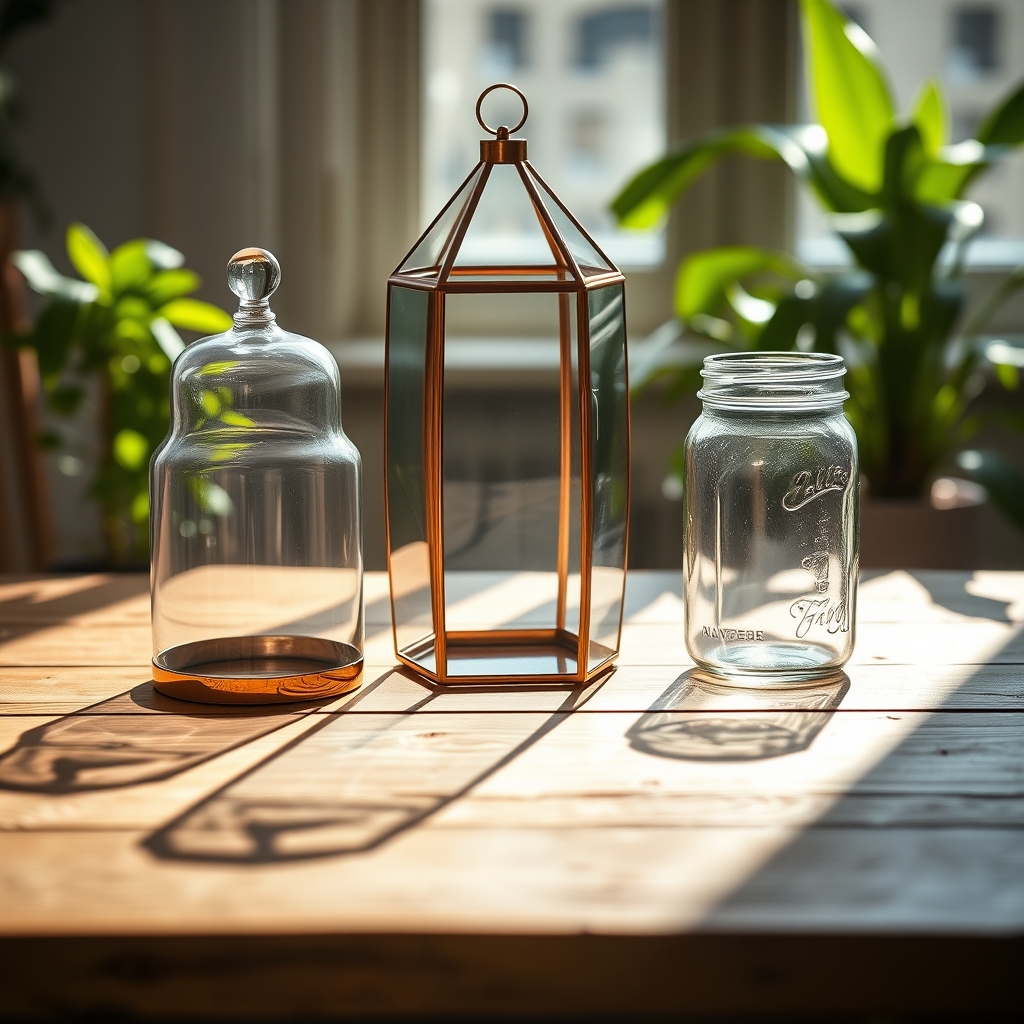
Choosing the perfect container is an essential step in designing a unique terrarium, as it sets the foundation for both the aesthetic and functionality of your miniature ecosystem. The container you select will determine the type of plants you can grow, the level of maintenance required, and the overall visual impact. Options range from classic glass jars and fishbowls to more unconventional choices like vintage lanterns or geometric glass shapes, each offering a distinct style and atmosphere.
When selecting a container, consider whether you want an open or closed design. Closed containers, such as lidded jars, create a humid environment ideal for tropical plants like ferns and mosses, while open containers suit succulents and other plants that thrive in drier conditions. Additionally, think about the size and shape of the container—larger ones allow for more elaborate designs and plant variety, while smaller ones are perfect for simple, minimalist displays. Make sure the container has adequate drainage or plan to add a drainage layer if needed to prevent root rot.
Lastly, the material and clarity of the container play a significant role in the terrarium’s appeal. Glass is the most popular choice due to its transparency, which showcases the layers and plants inside, but you can also experiment with materials like acrylic for a lightweight option. Make sure the container complements the space where it will be displayed, whether it’s a modern office or a cozy living room, to enhance the overall harmony of your design.
Selecting the Right Plants
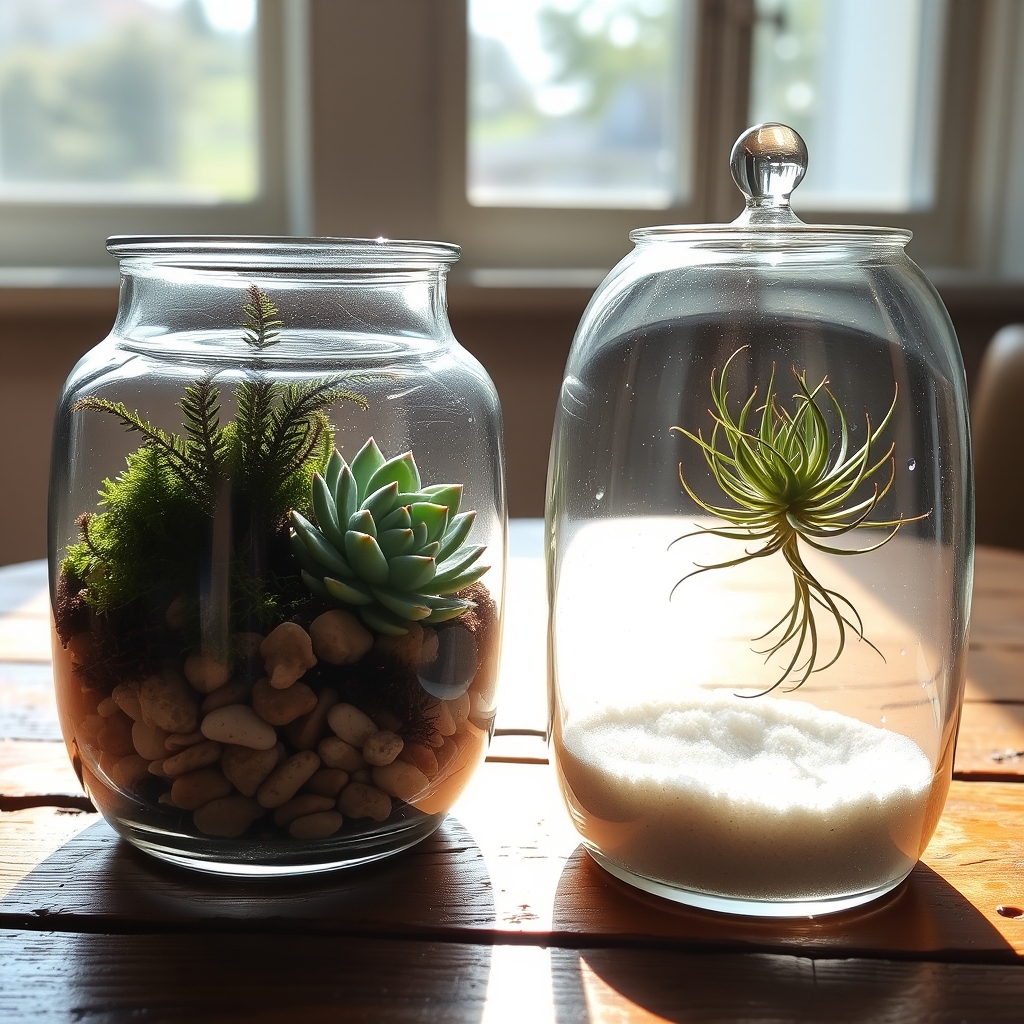
Selecting the right plants is an essential step in designing a unique terrarium that thrives. The choice of plants depends on the type of terrarium—whether it’s a closed, humid environment or an open, drier one. For closed terrariums, opt for moisture-loving plants like ferns, mosses, and small-leafed ivy, as they flourish in high humidity and require minimal airflow. In contrast, open terrariums are better suited for succulents, cacti, and air plants, which prefer drier conditions and good ventilation.
Consider the size and growth habits of the plants as well. Terrariums are typically small, enclosed spaces, so choose slow-growing or miniature varieties to prevent overcrowding. Make sure the plants have similar light and water needs to create a harmonious environment, as mismatched care requirements can lead to some plants thriving while others struggle.
Lastly, think about aesthetics and layering when selecting plants. Combine different textures, colors, and heights to create visual interest, such as pairing a tall, spiky plant with a low, creeping moss. By carefully selecting compatible plants, you can craft a miniature ecosystem that is both beautiful and sustainable.
Gathering Essential Materials
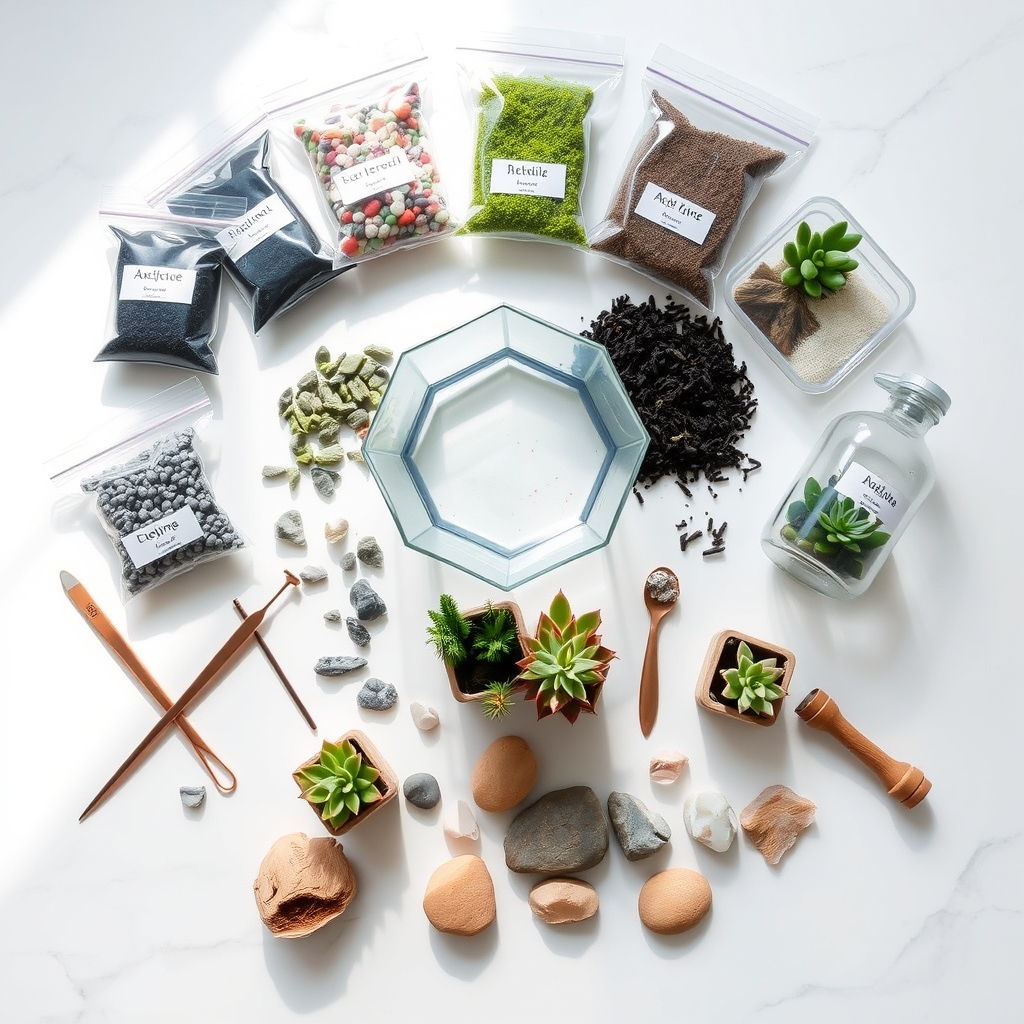
Gathering essential materials is a vital first step in designing a unique terrarium. To create a thriving miniature ecosystem, you’ll need a suitable glass container, which can range from a simple jar to a more elaborate geometric terrarium. The container should have a lid or be sealable if you’re creating a closed terrarium for tropical plants that require high humidity. Additionally, make sure you have a clear idea of the type of plants you want to include, as this will determine the other materials needed, such as specific substrates or drainage layers.
Beyond the container, key materials include a drainage layer, such as pebbles or activated charcoal, to prevent root rot by managing excess water. A barrier layer, like sphagnum moss, can be added to separate the drainage from the substrate, which could be potting soil, sand, or a specialized mix depending on your plants. You’ll also need small, slow-growing plants or succulents that thrive in confined spaces, along with decorative elements like rocks, driftwood, or figurines to personalize your terrarium. Having tools such as a small trowel, tweezers, and a spray bottle for watering will make the assembly process smoother.
Lastly, consider the light and humidity needs of your chosen plants when gathering materials. For instance, if you’re using ferns or mosses, you might need a mister to maintain moisture levels. Collecting all these materials beforehand guarantees a seamless design process, allowing you to focus on creativity and precision while building your terrarium.
Preparing the Base Layer
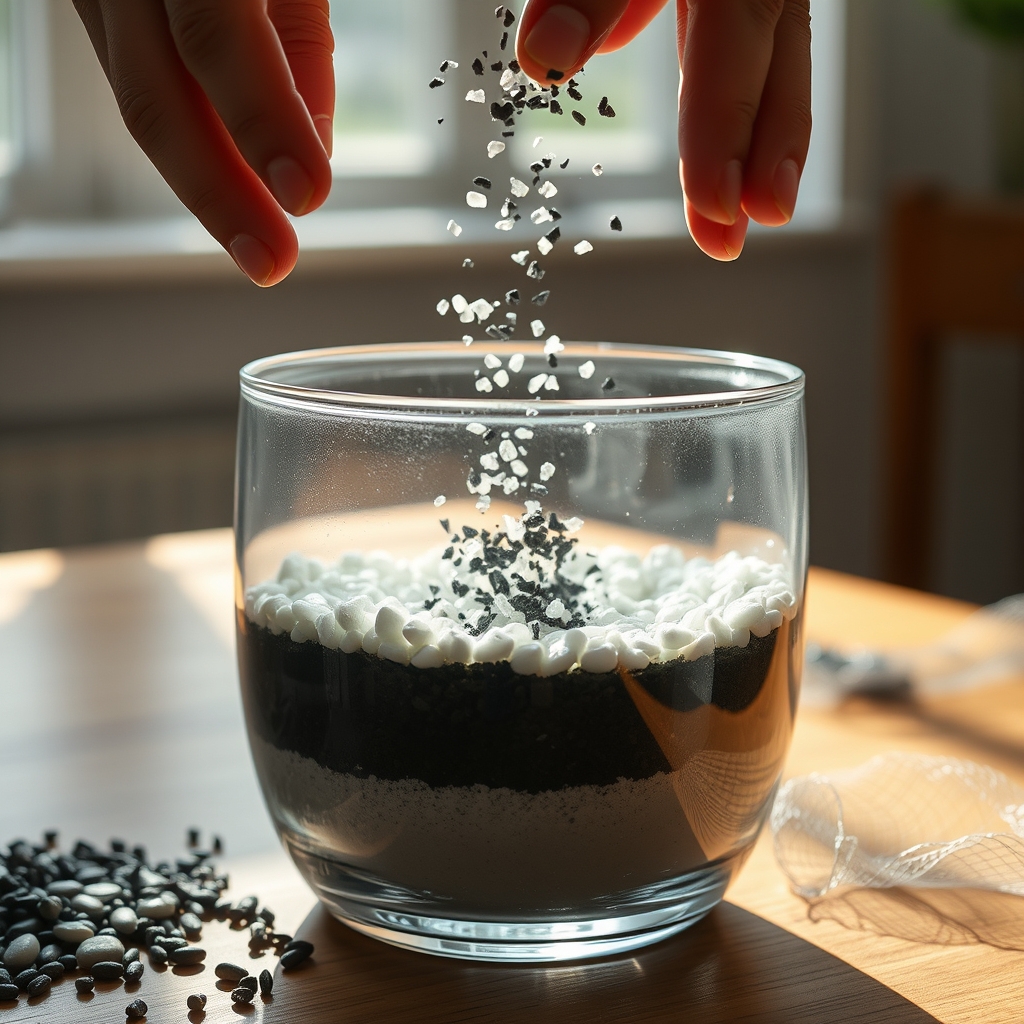
Preparing the base layer is an essential step in designing a unique terrarium, as it sets the foundation for a healthy and thriving miniature ecosystem. The base layer primarily serves as drainage to prevent water from pooling at the bottom, which can lead to root rot and mold growth. Start by selecting a suitable container with or without drainage holes, depending on the type of plants you plan to include, and make sure it is clean and dry before beginning.
To create the base layer, add a 1-2 inch layer of pebbles, gravel, or activated charcoal at the bottom of the container. This layer acts as a drainage system, allowing excess water to settle away from the plant roots. If using a container without drainage holes, consider adding a thin layer of activated charcoal on top of the pebbles to help absorb odors and prevent bacterial growth. This foundational step guarantees proper moisture balance, which is essential for the long-term health of your terrarium.
Finally, you can enhance the base layer by adding a barrier, such as a piece of mesh or sphagnum moss, over the drainage materials. This barrier prevents the soil or substrate from mixing with the drainage layer while still allowing water to pass through. Taking the time to carefully prepare the base layer will create a stable environment for your plants and contribute to the overall aesthetic and functionality of your unique terrarium design.
Adding Drainage Elements
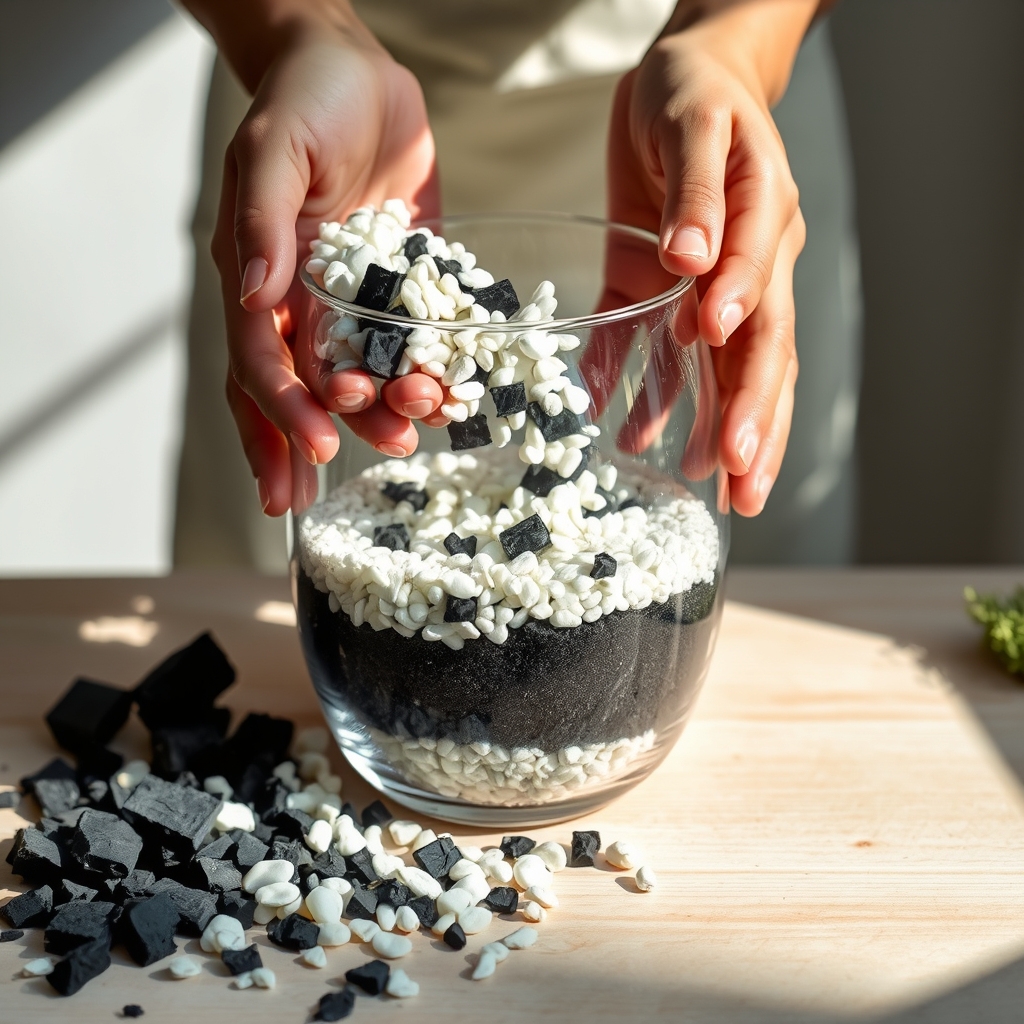
Adding drainage elements to a terrarium is an essential step in ensuring the health of the plants and preventing root rot. Terrariums are closed or semi-closed environments, which means excess water can easily accumulate at the bottom of the container. Without proper drainage, this standing water can lead to mold growth and damage the plant roots. Drainage elements act as a barrier, allowing excess water to collect away from the soil and roots while maintaining a balanced level of moisture.
To create an effective drainage layer, start by placing a 1-2 inch layer of materials like pebbles, gravel, or activated charcoal at the bottom of the terrarium container. These materials help to trap excess water and prevent it from saturating the soil above. Activated charcoal is particularly useful as it also helps to filter the water and reduce odors or bacterial growth in the enclosed space.
For added protection, you can place a thin layer of sphagnum moss or a mesh fabric over the drainage layer before adding the soil. This prevents the soil from mixing with the drainage materials while still allowing water to pass through. By carefully designing the drainage system, you create a sustainable environment where plants can thrive without the risk of overwatering.
Creating a Substrate Foundation
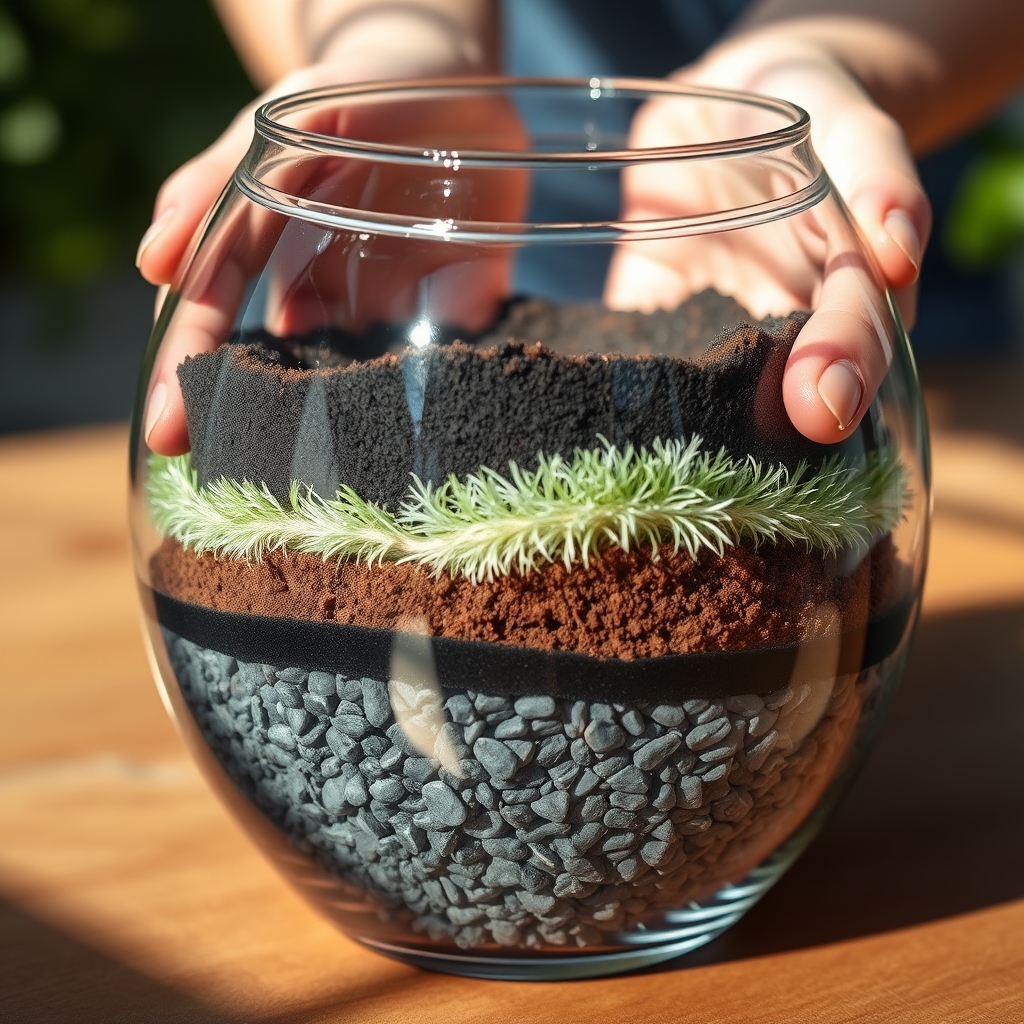
Creating a substrate foundation is a critical step in designing a unique terrarium, as it forms the base layer that supports plant growth and maintains the ecosystem’s balance. The substrate is the material placed at the bottom of the terrarium, acting as a medium for plant roots, aiding in drainage, and helping to regulate moisture levels. Choosing the right substrate depends on the type of plants and the environment you aim to create, whether it’s a tropical, desert, or woodland terrarium.
To start, a layer of drainage material, such as pebbles, gravel, or activated charcoal, is often placed at the bottom to prevent water from pooling and causing root rot. Above this, a barrier layer like sphagnum moss or a mesh fabric can be added to separate the drainage layer from the main substrate, preventing soil from mixing in and clogging the drainage. The main substrate layer, which could be a mix of potting soil, sand, or specialized terrarium soil, is then added to provide nutrients and a stable base for planting.
The thickness and composition of the substrate should be tailored to the needs of the plants, with deeper layers for species with extensive root systems and lighter mixes for succulents or cacti that prefer well-draining conditions. Experimenting with different textures and colors of substrate can also enhance the visual appeal of the terrarium, creating a natural and aesthetically pleasing foundation for your miniature ecosystem.
Arranging Your Greenery
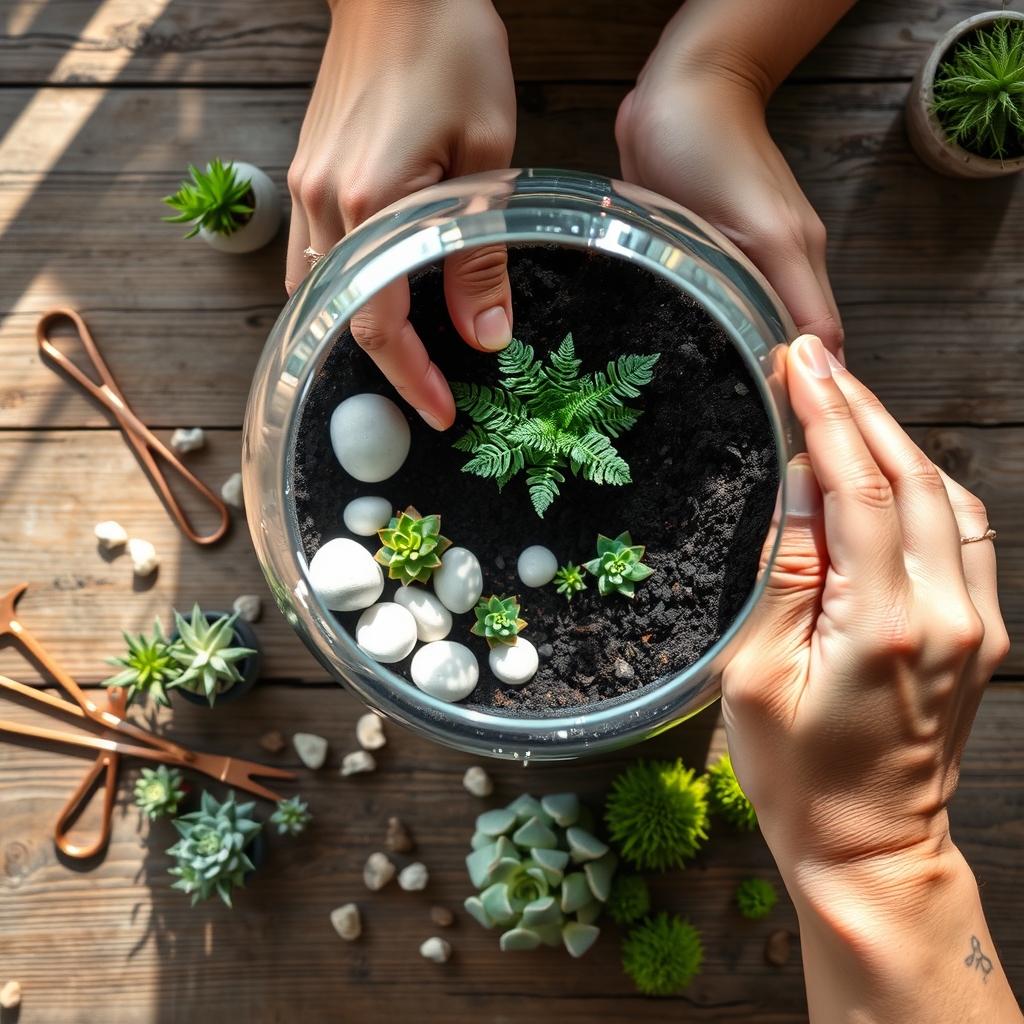
Arranging your greenery is a vital step in designing a unique terrarium, as it determines the overall aesthetic and balance of your miniature ecosystem. Start by planning the layout before placing any plants. Consider the height, texture, and color of each plant to create a harmonious composition. Taller plants can be positioned toward the back or center to add depth, while smaller, low-growing varieties work well in the foreground to create a layered effect. Guarantee that each plant has enough space to grow without overcrowding, as this will help maintain their health and prevent competition for light and nutrients.
When arranging, use a spoon or small trowel to dig shallow holes for the roots, and gently place the plants into the substrate, pressing the soil around them to secure their position. Pay attention to the natural flow of the design, mimicking how plants might grow in a natural environment. For instance, cluster mosses or ferns together to create a lush, forest-like feel, or position a striking succulent as a focal point. Adding decorative elements like rocks, driftwood, or figurines can enhance the visual appeal, but be mindful not to overshadow the greenery.
Finally, consider the light requirements of your plants during arrangement. Place those needing more light closer to the top or near the glass walls of the terrarium, while shade-loving plants can thrive in lower or more sheltered spots. After arranging, water the plants lightly to help them settle, and observe the terrarium over the next few days to guarantee the layout supports their growth. A well-thought-out arrangement not only creates a stunning visual but also guarantees the long-term health of your terrarium’s ecosystem.
Incorporating Decorative Features
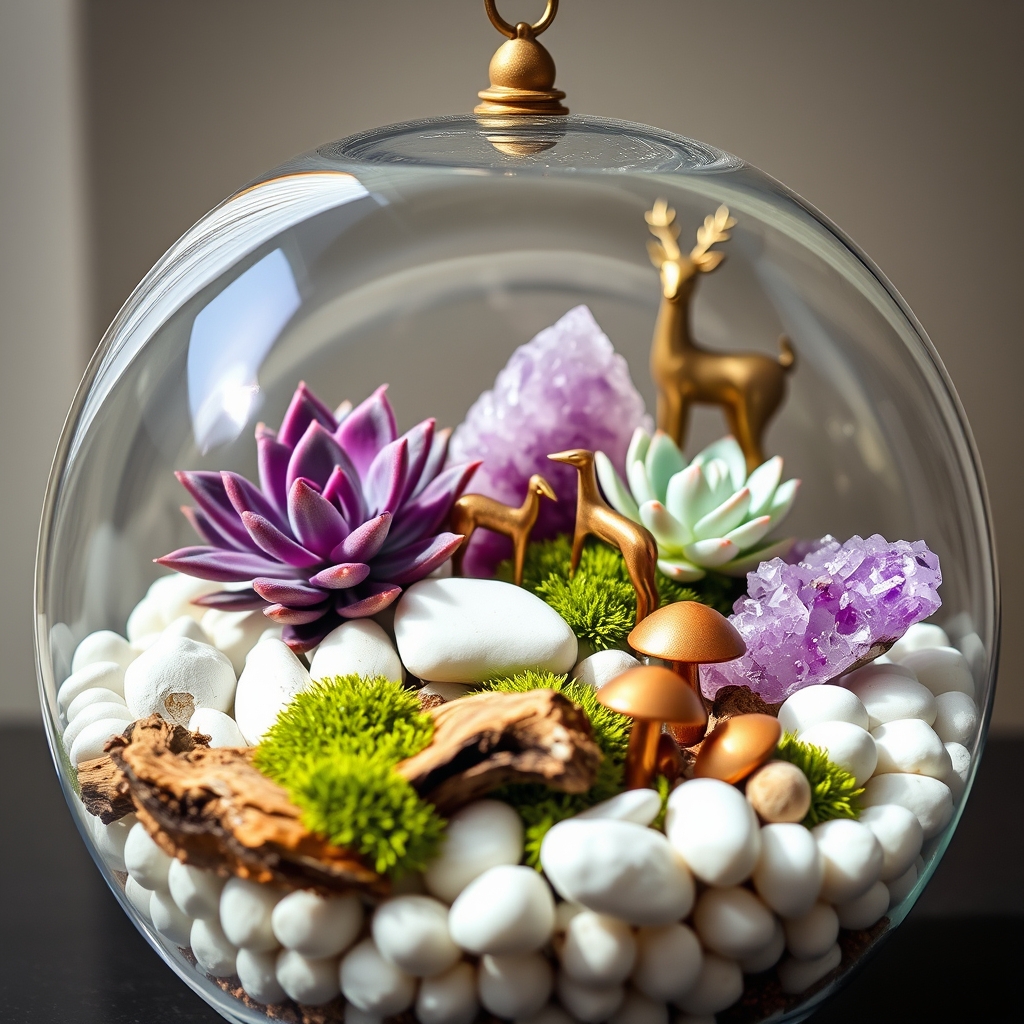
Incorporating decorative features into a terrarium is a fantastic way to personalize and enhance its visual appeal. These elements can transform a simple glass container of plants into a miniature world that reflects your style or tells a story. Decorative features can include natural items like rocks, driftwood, and shells, as well as whimsical additions such as tiny figurines, fairy garden accessories, or colorful glass beads. The key is to choose items that complement the plants and theme of your terrarium while maintaining a balanced and uncluttered look.
When selecting decorative elements, consider the scale and environment of your terrarium to achieve harmony. For instance, small pebbles or moss-covered stones can mimic a natural landscape, while a small ceramic animal or a miniature bridge can add a playful or fantastical touch. Be mindful of the materials you use—avoid items that may degrade or release harmful substances into the enclosed ecosystem. Placement is also vital; arrange decorations to create depth and focal points, such as placing taller elements at the back and smaller ones in the foreground to draw the eye through the scene.
Experimenting with textures and colors can further elevate the design of your terrarium. Combining rough, natural elements like bark with smooth, polished stones or vibrant accents can create contrast and interest. Ultimately, the decorative features should enhance the overall aesthetic without overwhelming the living components, guaranteeing that the plants remain the centerpiece of your tiny ecosystem.
Balancing Light and Location
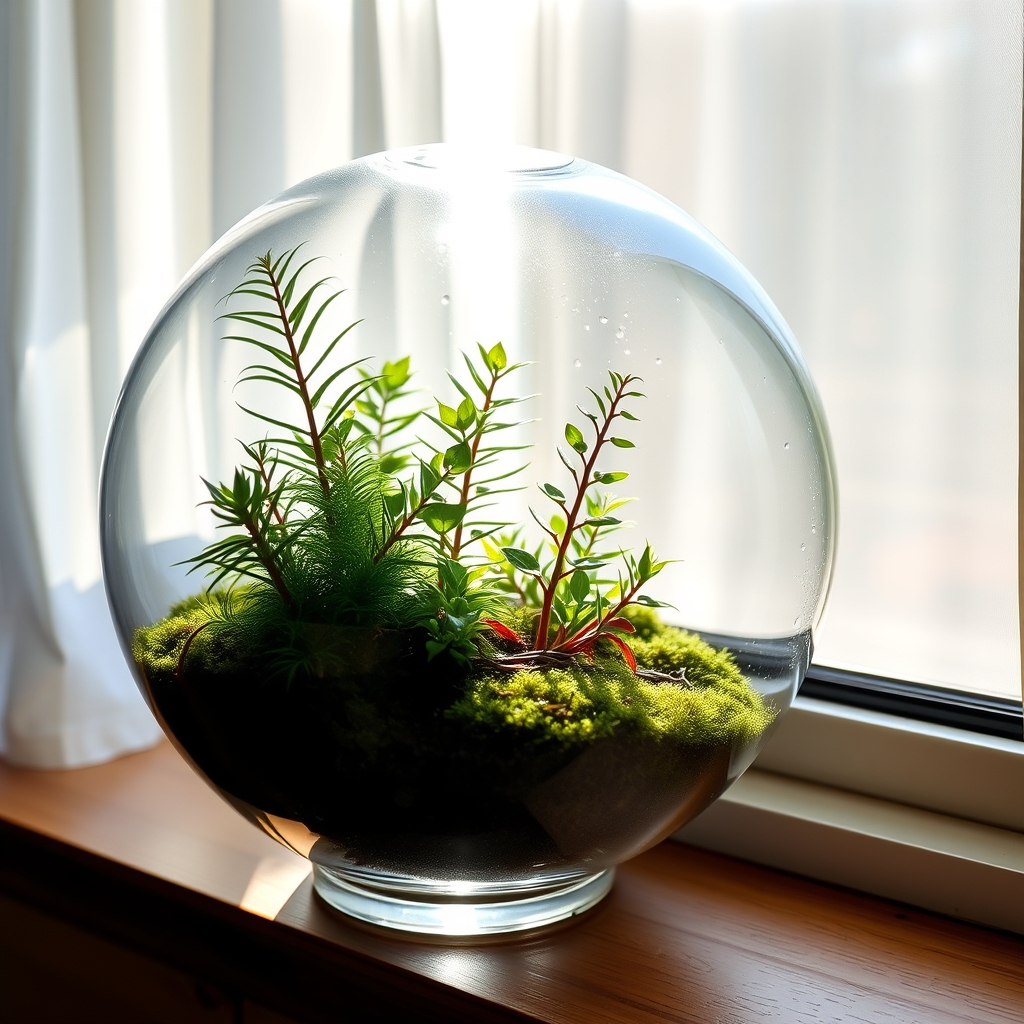
Balancing light and location is a critical aspect of designing and maintaining a thriving terrarium. Different plants have varying light requirements, and understanding these needs is essential for their health. For instance, tropical plants often thrive in bright, indirect light, while succulents and cacti prefer direct sunlight. Placing a terrarium in the right spot—whether near a north-facing window for softer light or a south-facing one for more intensity—can make all the difference in guaranteeing the plants inside flourish.
Additionally, the location of a terrarium affects not only light exposure but also temperature and humidity, which are equally important for plant growth. Avoid placing terrariums near heat sources like radiators or air vents, as these can cause fluctuations that stress the plants. Rotating the terrarium occasionally can help guarantee even light distribution, preventing one side from becoming leggy or overexposed. By carefully considering both light and location, you can create a balanced environment that supports the unique ecosystem within your terrarium.
Watering Your Mini Ecosystem
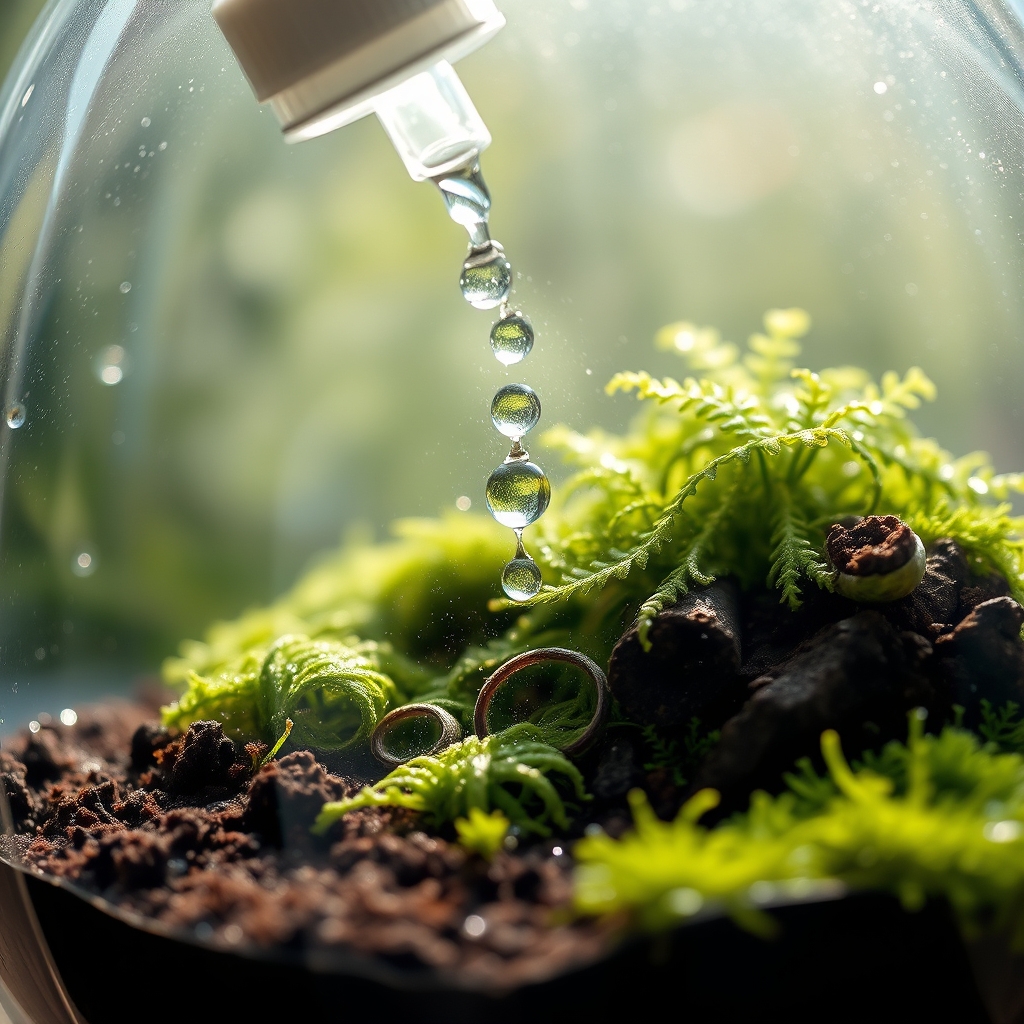
Watering your mini ecosystem is a vital aspect of maintaining a healthy terrarium. Unlike traditional houseplants, terrariums create a self-sustaining environment where water cycles through evaporation and condensation. However, they still require occasional watering to replenish moisture levels, especially if the ecosystem is not fully sealed or if the plants inside have specific needs. The key is to avoid overwatering, as excess moisture can lead to mold growth, root rot, and other issues that can harm your delicate plants.
To water your terrarium, use a small spray bottle or dropper to apply water directly to the soil or moss, ensuring you don’t soak the plants. For closed terrariums, water sparingly—often just a few tablespoons every few weeks—since the enclosed environment retains moisture. Open terrariums may need more frequent watering, depending on the humidity and airflow in your space, but always check the soil’s dryness before adding more. Observe the glass for condensation; if it’s consistently foggy, hold off on watering, as this indicates sufficient moisture.
Additionally, consider the type of plants in your terrarium, as tropical species may require more humidity, while succulents and cacti prefer drier conditions. Use distilled or rainwater to avoid mineral buildup from tap water, which can affect plant health over time. By monitoring your terrarium’s unique needs and watering with care, you’ll help maintain a thriving mini ecosystem.
Maintaining Proper Humidity
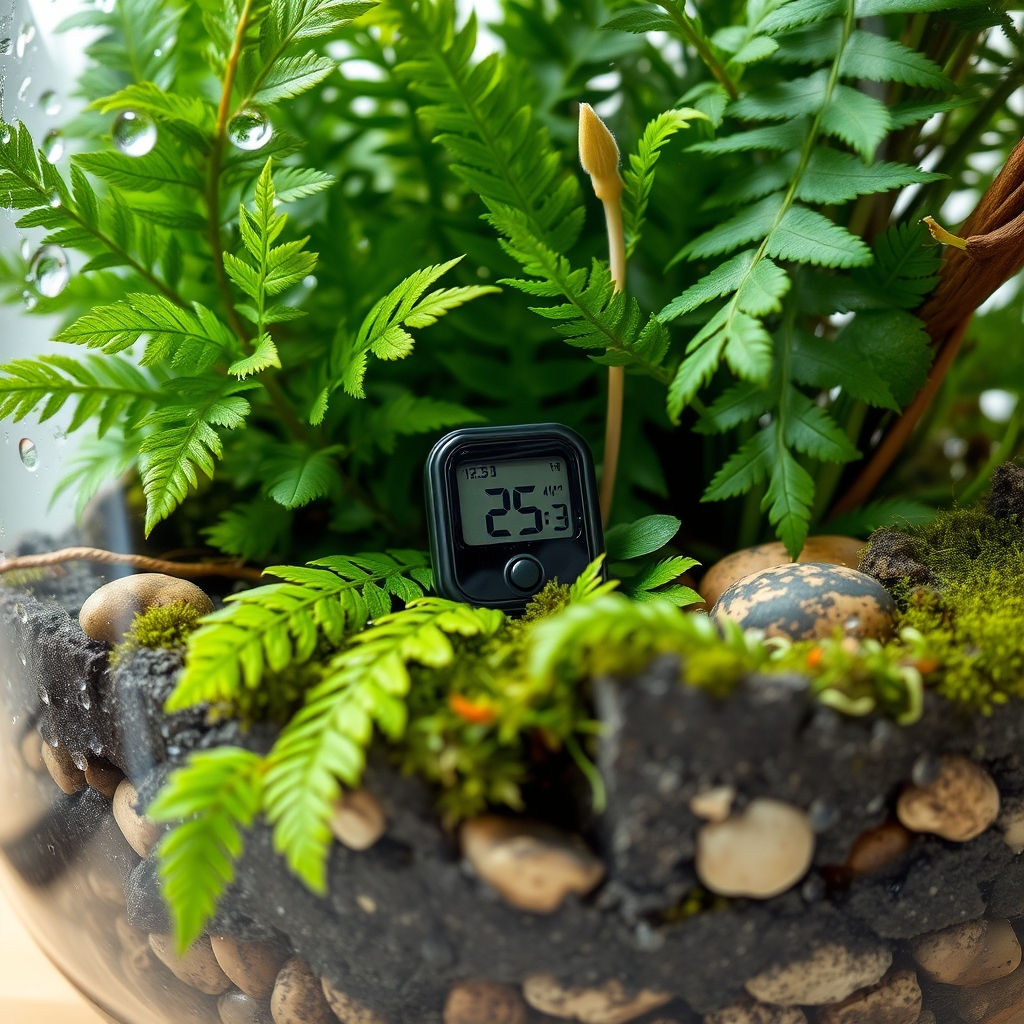
Maintaining proper humidity is essential for the health of plants and organisms within a terrarium. Different plants require varying levels of moisture in the air, with tropical species often needing higher humidity (around 70-90%) compared to succulents or desert plants, which thrive in drier conditions (30-50%). To achieve the right balance, it’s important to monitor humidity levels using a hygrometer, a small device that measures moisture in the air, and adjust accordingly based on the needs of your terrarium’s inhabitants.
One effective way to control humidity is by adjusting the terrarium’s ventilation. A closed terrarium with a lid will naturally retain more moisture, creating a humid environment ideal for tropical plants, mosses, and ferns. Conversely, an open terrarium allows for more air circulation, reducing humidity for plants that prefer drier conditions. If humidity is too low, you can mist the inside of the terrarium with water or place a small dish of water inside to increase moisture levels. If it’s too high, briefly opening the lid or adding ventilation holes can help reduce excess moisture and prevent mold growth.
Additionally, the substrate and water management play a role in humidity control. Using a moisture-retaining substrate like sphagnum moss can help maintain higher humidity, while ensuring proper drainage layers prevents waterlogging, which can lead to root rot. Regularly check for condensation on the glass; excessive condensation may indicate overly high humidity, while a complete lack of it might suggest the environment is too dry. By fine-tuning these elements, you can create a stable, thriving ecosystem tailored to your terrarium’s specific needs.
Pruning and Trimming Tips
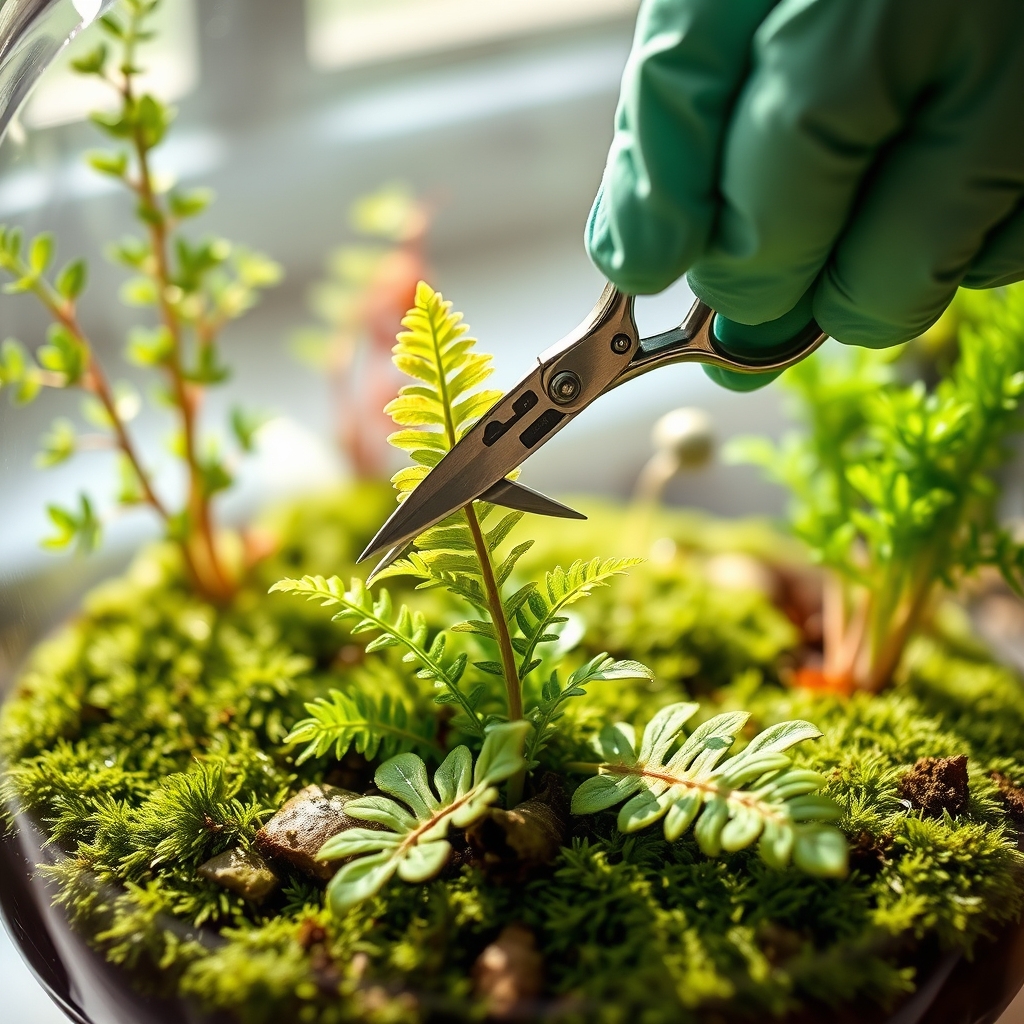
Pruning and trimming are essential practices for maintaining the health and aesthetic appeal of plants within a terrarium. Regular pruning helps control the growth of plants, preventing them from overcrowding the limited space and ensuring that light and air circulation reach all parts of the terrarium. It also encourages bushier growth and prevents any single plant from dominating the miniature ecosystem, which could disrupt the balance of the environment.
To effectively prune and trim, use small, sharp scissors or pruning shears designed for delicate work to avoid damaging the plants. Focus on removing dead or yellowing leaves, as well as any overgrown stems that may be encroaching on neighboring plants or the terrarium walls. Be mindful to trim only what is necessary, as over-pruning can stress the plants and hinder their growth. Always clean your tools before and after use to prevent the spread of disease.
Additionally, timing is important when pruning terrarium plants. Perform trimming during the growing season, typically spring or early summer, when plants are most resilient and can recover quickly. After pruning, monitor the terrarium for any signs of stress or imbalance, and adjust care routines as needed to support the plants’ recovery and maintain the overall harmony of the enclosed ecosystem.
Troubleshooting Common Issues
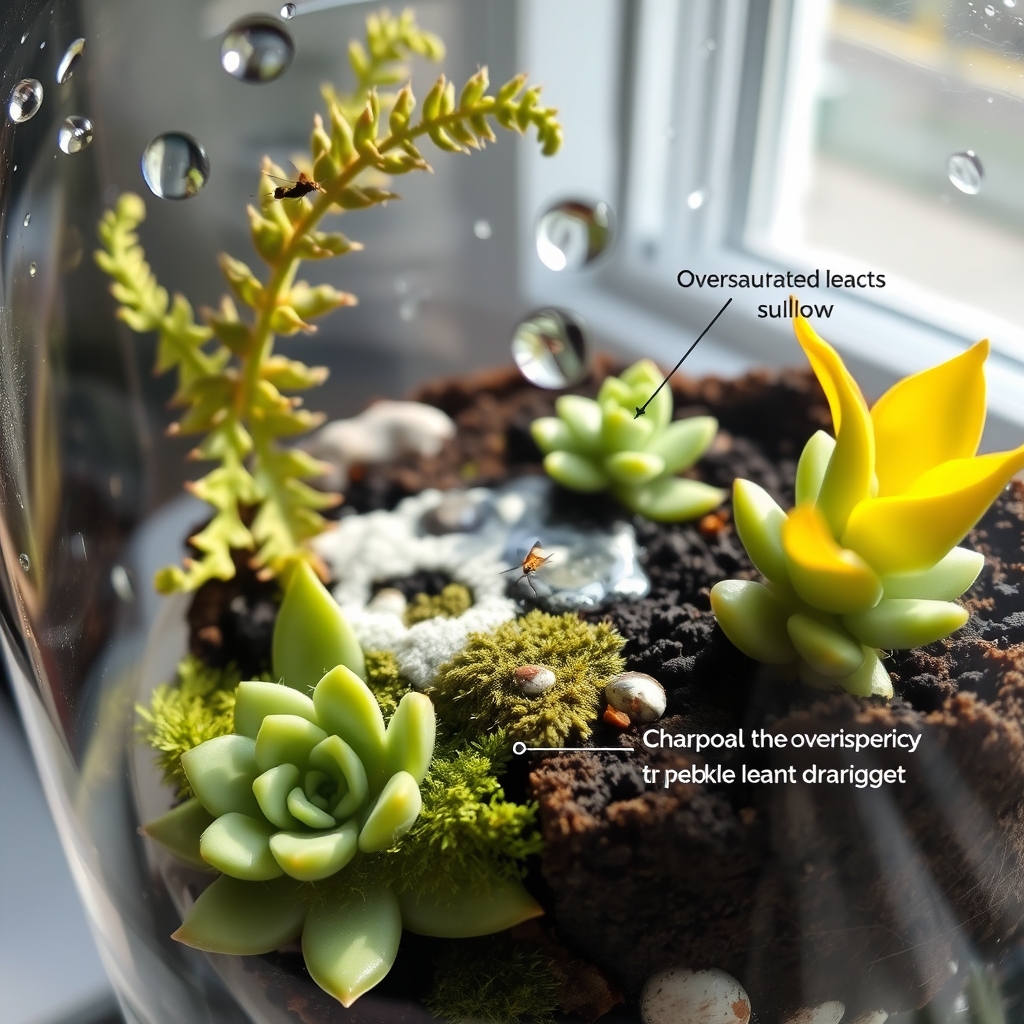
Troubleshooting common issues in terrarium design is essential to maintaining a healthy and thriving miniature ecosystem. One frequent problem is overwatering, which can lead to root rot and mold growth. To address this, secure proper drainage by using a layer of pebbles or activated charcoal at the bottom of the terrarium, and only water when the soil appears dry. Additionally, if mold appears, remove affected areas immediately and increase ventilation by opening the terrarium lid for a few hours to reduce humidity.
Another common issue is insufficient light, which can cause plants to become leggy or fail to thrive. If your terrarium is not receiving enough natural light, consider placing it near a bright, indirect light source or supplementing with a grow light. Conversely, too much direct sunlight can scorch plants or overheat the terrarium, so monitor the environment and adjust the placement as needed. Regularly inspect your terrarium for pests like gnats or spider mites, and treat infestations promptly with natural pest control methods or by isolating affected plants.
Lastly, maintaining the right balance of humidity and temperature is vital. If the terrarium is too dry, mist the plants lightly or add a small water feature to increase moisture. If condensation builds up excessively on the glass, it may indicate overly high humidity, so improve airflow by partially opening the lid. By addressing these common issues with proactive care and observation, you can guarantee your terrarium remains a vibrant and beautiful display.
Personalizing Your Green Space
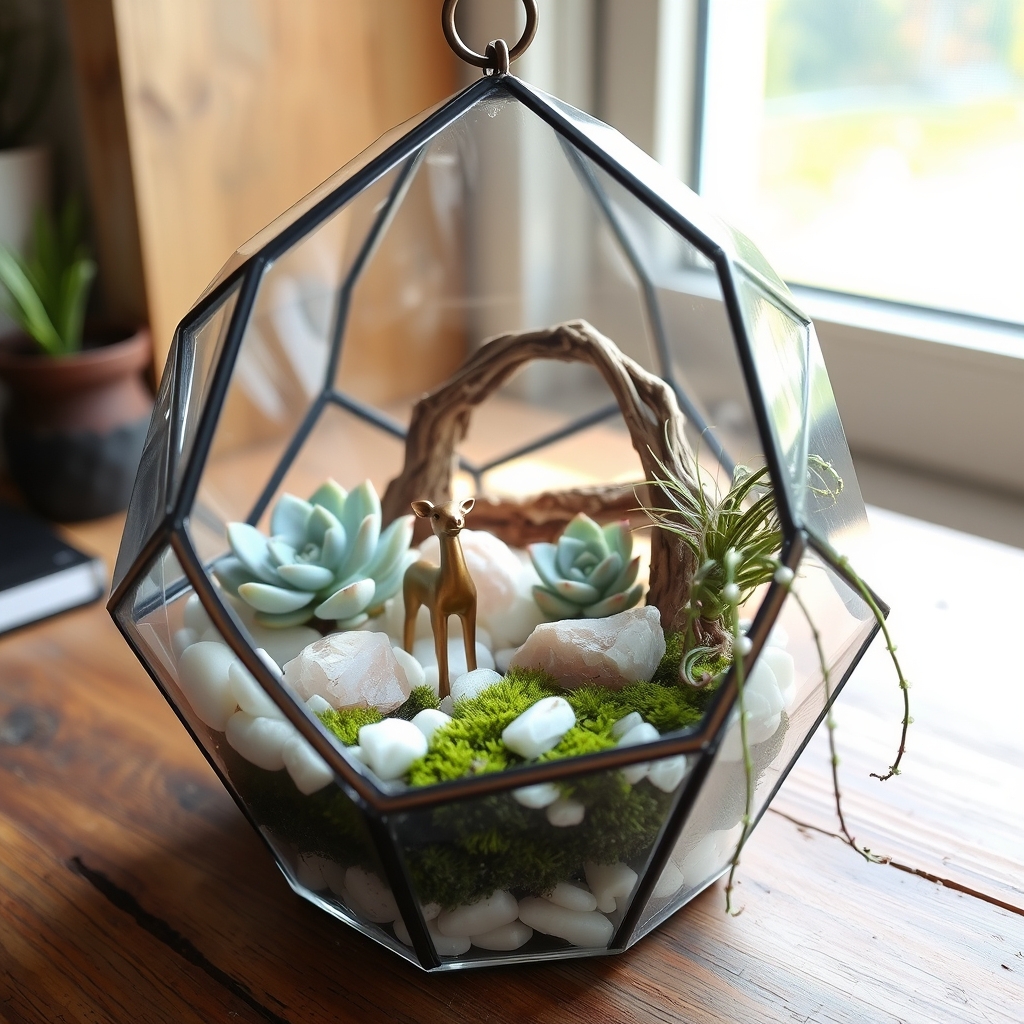
Personalizing your green space is a key aspect of designing a unique terrarium that reflects your style and personality. A terrarium is more than just a miniature garden; it’s a canvas for creativity where you can incorporate elements that resonate with you. Whether you prefer a minimalist aesthetic with clean lines and simple plants like succulents, or a lush, tropical vibe with vibrant moss and ferns, the choice of plants, containers, and decor can transform your terrarium into a personal statement.
Start by selecting a container that matches your vision—think beyond traditional glass jars to include vintage teacups, geometric shapes, or even repurposed items like old light bulbs. Add personal touches with small figurines, colorful pebbles, or driftwood that tell a story or evoke a memory. For instance, a tiny ceramic animal might remind you of a beloved pet, or a specific stone could be a memento from a meaningful trip. These details make your terrarium a unique reflection of your experiences and interests.
Finally, consider the placement of your terrarium in your home or workspace to enhance its personal significance. Positioning it on a desk where you spend most of your time, or in a cozy corner of your living room, can create a calming focal point that connects you to nature. By tailoring every element—from the plants to the tiny trinkets—you guarantee that your green space is not just a decoration, but a deeply personal sanctuary.
